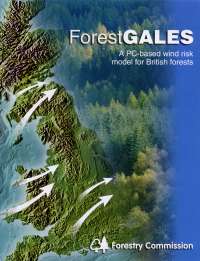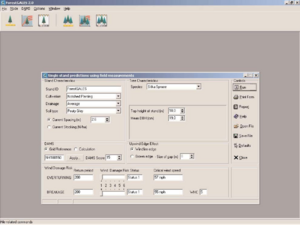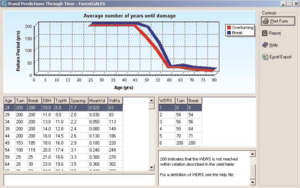ForestGales
Wiki quality control
| Has flag | N/A |
|---|
Name, responsible organisation and contact person
| Has full name | ForestGales |
|---|---|
| Has acronym | ForestGales |
| Has wiki contact person | Stephen Bathgate |
| Has wiki contact e-mail | stephen.bathgate@forestry.gsi.gov.uk |
Software identification
| Has software | ForestGales.Software |
|---|
Description
| Has description | ForestGALES allows the analysis of wind climate effects on the stability of a conifer forest. The tool can be used to assess risk over time via predicted growth from yield tables or alternatively current risk from mensuration data (top height and dbh).
It evaluates the wind hazard of a conifer stand plantation, based on some of the stand feature, like soil, cultivation, drainage, location, or metric measures (top height, average dbh) of the existing species. It provides information as the return period for that damage to occur, risk status and critical wind speed for both overturning and stem breakage risk. It allows to quantify the wind hazard existing in actual stands or, with the help of growth prediction models or yield tables, the future risk of wind damage assumed by current decisions on the establishment of new plantations, drainage improvements, thinning options, clear-cutting impact, rotation periods or the creation of retentions. ForestGALES can be used to calculate the risk for a particular stand in the single stand mode, or in the batch or multiple stand mode, for a number of stands one after another. Within these two modes there are three ways of making predictions: using field measurements, using stand characteristics provided by a yield model, or making predictions through time, calculating the risk of damage over a typical rotation from stand characteristics contained in yield models. Recently adapted as part of Stormrisk project to allow model to run in partner countries. |
|---|---|
| Has modelling scope | Forest indicators |
| Has temporal scale | Long term (strategic), Medium term (tactical), Short term (operational) |
| Has spatial context | Spatial with no neighbourhood interrelations |
| Has spatial scale | Forest level, Regional/national level, Stand level |
| Has objectives dimension | Single objective |
| Has related DSS | |
| Has goods and services dimension | Non-market services |
| Has decision making dimension | Single decision maker |
| Has forest management goal | storm behaviour, wind hazard |
| Supports tree species | Sitka Spruce, Norway Spruce, Douglas Fir, Scots Pine, Corsican Pine, Lodgepole Pine, Western Red Cedar, Western Hemlock, Noble Fir, Grand Fir, Japanese Larch, Hybrid Larch, European Larch |
| Supports silvicultural regime | even-aged |
Concrete application
| Has typical use case | |
|---|---|
| Has user profile | forest owners associations, private legal entities (cooperatives / corporations / trusts / partnerships / condominium associations), public land managers (i.e. state-owned / federal / cantonal / communal forests), national forest administration, NGO, service providers |
| Has country | United Kingdom |
| Has references about examples of application | |
| Has number of users | >100 |
| Has number of real-life applications | >100 |
| Has utilisation in education | used by students |
| Has research project reference | |
| Has tool dissemination |
Decision support techniques used in the DSS
| Has decision support techniques | ForestGales.Decision support techniques |
|---|
Support of Knowledge Management
| Has knowledge management processes | ForestGales.Knowledge management process |
|---|
Support of social participation
| Has support for social participation | ForestGales.Support of social participation |
|---|
DSS development
| Has DSS development | ForestGales.Description of DSS development |
|---|
Documentation
| Has website | |
|---|---|
| Has online demo | https://www.eforestry.gov.uk/forestdss |
| Has manual | Yes |
| Has technical documentation | No |
| Has reference | [[Has reference::* ForestGALES website
|
General System description
System name: Geographic Analysis of the Losses and Effects of Storms in Forestry
Acronym: ForestGALES
Brief overview
ForestGALES allows the analysis of wind climate effects on the stability of a conifer forest. The tool can be used to assess risk over time via predicted growth from yield tables or alternatively current risk from mensuration data (top height and dbh).
Recently adapted as part of Stormrisk project to allow model to run in partner countries.Contents
- 1 Wiki quality control
- 2 Name, responsible organisation and contact person
- 3 Software identification
- 4 Description
- 5 Concrete application
- 6 Decision support techniques used in the DSS
- 7 Support of Knowledge Management
- 8 Support of social participation
- 9 DSS development
- 10 Documentation
- 11 General System description
- 12 Data and data models
- 13 Models
- 14 Decision Support
- 15 Output
- 16 System
- 17 References
Scope of the system
This is a probability-based model that has been delivered as a DSS. It evaluates the wind hazard of a conifer stand plantation, based on some of the stand feature, like soil, cultivation, drainage, location, or metric measures (top height, average dbh) of the existing species. It provides information as the return period for that damage to occur, risk status and critical wind speed for both overturning and stem breakage risk. It allows to quantify the wind hazard existing in actual stands or, with the help of growth prediction models or yield tables, the future risk of wind damage assumed by current decisions on the establishment of new plantations, drainage improvements, thinning options, clear-cutting impact, rotation periods or the creation of retentions.
ForestGALES can be used to calculate the risk for a particular stand in the single stand mode, or in the batch or multiple stand mode, for a number of stands one after another. Within these two modes there are three ways of making predictions: using field measurements, using stand characteristics provided by a yield model, or making predictions through time, calculating the risk of damage over a typical rotation from stand characteristics contained in yield models.
System origin
- Developed by the Stability project team from the GB Forestry Commission.
- ForestGALES was designed in consultation with representatives of both private and state forestry organisations.
- ForestGALES 2.1 PC-based version can be purchased by 130£. There is also a free, web-based, reduced, single stand version available within the GB Forestry Decision Support System previous registration.
- Used in research, education, public and private sector forestry.
Support for specific issues
Wind hazard, it estimates critical wind speed that will cause damage.
Also, the model allows greater flexibility for testing different forest-management scenarios such as the choice of cultivation, thinning options, drainage improvements, the impact of clear-cutting and the creation of retentions.
Support for specific thematic areas of a problem type
- Silvicultural
- Certification
- Conservation
- Restoration
- Development choices / land use zoning
- Policy/intervention alternatives
- Sustainability impact assessment (SIA)
Capability to support decision making phases
- Intelligence
- gives user detailed site analysis (climate and soil parameters).
- Design
- provides site analysis in context of many themes.
- Choice
- allows user to vary species choice, management options.
- Monitor
- highlights risks which in theory could encourage monitoring.
Related systems
- GB Forestry DSS
- Conifer Timber Quality Model
- ESC
- EMIS
- HMSS
- ForestGALES is part of the STORMRISK project, which aims to prevent the North Sea Region from the effects of storm felling in forest landscapes.
Data and data models
Typical spatial extent of application
Stand based tool operates at stand scale upto 10 hectares, batch GIS tool has generated regional and national scenarios.
Forest data input
Location via OS GB six figure grid reference, e.g., NT090950. This allows site windiness to be determined from a digital map.
Type of information input from user (via GUI)
In the Predictions using field measurements mode the users have to input the characteristics of stand (name, cultivation, drainage, soil type, and stocking), tree (species, top height of stand, and mean DBH), and the type of trees standing on the edge. DAMS (measure of site windiness) can be introduced through the grid reference of the site or can be calculated introducing some stand topography characteristics. If the Predictions using yield models is chosen, the tree characteristics would be calculated from yield models, having the user to introduce the yield class, thinning regime, initial spacing, and age from the stand. In Predictions through time mode no new information from the above explained is required.
The available species are:
- Scots pine
- Corsican pine
- Lodgepole pine
- European larch
- Japanese larch
- Hybrid larch
- Douglas fir
- Noble fir
- Grand fir
- Sitka spruce
- Norway spruce
- Western hemlock
Models
Forest models
The ForestGALES model takes into account the effect of species, cultivation, drainage and silviculture. Using information about the site (including soil and cultivation) and the trees (such as species and height), the model first calculates the wind speed at which trees will be damaged either by uprooting or stem breakage. A mechanistic model is used in order to estimate this parameter. The probability of damaging winds occurring is then calculated using information on the wind climate.
Decision Support
Definition of management interventions
Thinning, no thinning, spacing, stocking density, creation of brown edge (i.e. removing windfirm edge and creating gap).
Prescription enumerating all selected possibilities at stand level, coarser information in GIS layers.
Typical temporal scale of application
Allows full lifecycle analysis of a rotation 15-80 years depending upon species.
Types of decisions supported
- Management level
- strategic decisions
- administrative decisions
- operating control decisions
- Management function
- planning decisions
- organizing decisions
- command decisions
- control decisions
- coordination decisions
- decision making situation
- unilateral
- collegial
Decision-making processes and models
- Logic modeling
- Multiple criteria/ranking
Output
Types of outputs
Stand version displays critical wind speed, return period, and wind damage risk status. Thematic maps can be generated via a batch tool for visualisation in GIS.
In the Predictions through time mode the results are displayed in a graphic and a table showing the return period in years for damaging storms at intervals throughout the rotation.
There are export facilities allowing results to be sent to Microsoft® Word as a .doc or .rtf file in the Single Stand mode and to Microsoft® Excel® in Batch Mode for display, storage and printing.
Spatial analysis capabilities
The main part of ForestGALES (that does the calculations) was constructed as a stand-alone dynamic link library (DLL), being accessible from other programs, so made it easily integrated with GIS software such as ArcView.
Abilities to address interdisciplinary, multi-scaled, and political issues
Evaluate interactions between different basic information types (biophysical, economic, social). Produce coordinated results for decision makers operating at different spatial scales facilitate social negotiation and learning
System
System requirements
- The commercial version was designed to run under Microsoft® Windows® OS.
- Pentium 133 MHz processor or better
- 500 MB free hard disk space (for full installation including wind scores)
- 128 MB RAM (minimum)
- CD-ROM drive
- Super VGA (800x600) or higher resolution monitor
- Recommended: Microsoft Excel/Word 97® or above to use data export facilities
Architecture and major DSS components
Desktop UI was written in Delphi™ as a PC-based system.
The application has also been adapted to link to the ArcView™ GIS system using Avenue™ scripting.
Usage
Used in education, public and private sector forestry and research.
Initially developed in Scotland for its usage in the British forests, has since been adapted for use New Zealand, south-west France, eastern Canada and Japan. Also, an adaptation that allows input parameters and wind climate to be easily modified for other countries will be made available.
Computational limitations
Runtime can be an issue for landscape scale analysis over time, but still not more than a few hours.
User interface
The appearance of ForestGALES offers a consistent view designed for easier operation.
For GIS offline service to process data and return a spatial layer with wind risk variables attached. Processing via command line UI. Visualisation any GIS tool.
Documentation and support
Manual available for desktop version. Support available via email and extensive on-line help.
ForestGALES training courses were run in the past with regularity, but now are being run when there is sufficient demand.
Installation
- Desktop version is easy to install in MS Windows with the program's CD.
- Online reduced version only requires a web-browser and an internet access.
References
External resources
- ForestGALES website
- Forest Research Decision Support Portal (note registration required)
- GARDINER B., J SUÁREZ, A. ACHIM, S. HALE et B. NICOLL (2006): ForestGALES. A PC-based wind risk model for British Forests. User’s Guide. Version 2.1. Forestry Commission. (available on-line in pdf)
- REYNOLDS K.M., TWERY M., LEXER M.J., VACIK H., RAY D., SHAO G,. et BORGES J.G.: Decision Support Systems in Forest Management IN BURSTEIN F. et HOLSAPPLE C. W. (EDS.) (2008): Handbook on Decision Support Systems 2: Variations. Springer Berlin Heidelberg. 800 pp.


